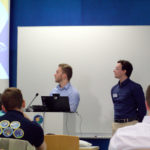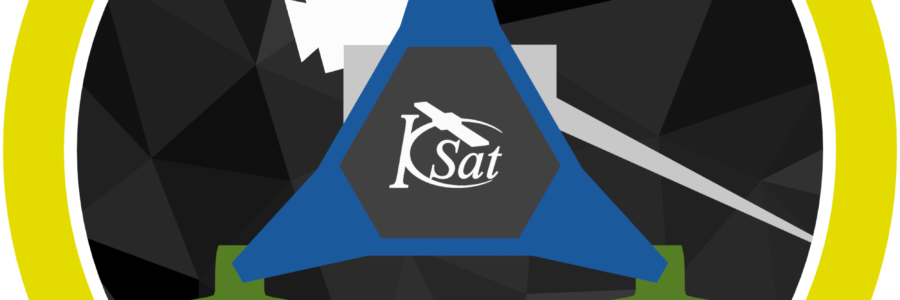On February 2nd, 2019 the PDR of SOURCE took place at the Institute for Space Systems of the University of Stuttgart (IRS).
The aim of the day was to conclude project phase B, in which the preliminary design of the satellite had been developed. In addition to a project milestone for SOURCE, the review represented an examination performance at the end of the semester for all participants of the corresponding lecture.
Besides the reviewers, who came from Tesat-Spacecom, Thales Alenia Space and Airbus as well as from DLR Bremen and Baylor University, the SOURCE team also welcomed numerous guests. Among them were not only members of the IRS institute and employees of the SOURCE project partner IRAS, but also students of the friendly student society TU Darmstadt Space Technology e.V. (TUDSat). This way, the SOURCE PDR had more than 70 participants in total.
The review began at 10:00 a.m. with the presentation of all subsystems, the system engineers and the team lead. Within about two hours, the current status of the entire satellite system was presented. In the following break the team already got many positive remarks about the endurance and motivation with which the students are working on SOURCE. In the afternoon, reviewers and guests had time to ask questions and make comments.
Following the review, the supervising university teacher Professor Sabine Klinkner was very satisfied with the professional conduct of the review, "I was particularly pleased with how confidently the students answered the experts' questions. They really impressed the space professionals".
Despite the rather cool weather and the onset of darkness, the SOURCE team let the evening end on the roof of the institute, while the Review Board discussed the outcome of the review.
In the end, the Review Board agreed on recommending to continue with Phase C once all RIDs (Review Item Discrepancies) had been processed. The result of the review is thus, as in Phase A, a conditional pass, so the next goal is to close all the RIDs by the beginning of the next semester in order to start phase C in time.
The SOURCE team would like to thank all guests and especially the reviewers for their interest and commitment in making the PDR of SOURCE possible.
Category: Allgemein-EN
ROACH
ROACH (Robotic in-Orbit Analysis of Cover Hulls) researches the use of electrostatic adhesion for new locomotion methods in space. ROACH launched within the REXUS/BEXUS program aboard REXUS 24 in March 2018. ROACH2 will be launched aboard REXUS 28 in March 2020.
The project is inspired by the increasing threat to spacecraft posed by space debris and micro-meteorites. Hulls of spacecraft are additionally subject to fatigue, e. g. due to radiation. Both sources of damage can potentially destroy or impair the spacecraft. Based on this experiment, robots may enable autonomous maintenance by searching for damage and performing small repairs. The locomotion of such a rover on a spacecraft’s hull and its adhesion to the spacecraft is the primary challenge. The principle of electrostatic adhesion shall be used to achieve that.
MIRKA2-ICV
MIRKA2-ICV (Mikrorückkehrkapsel 2 - In-flight Communication Verification) is a successor to MIRKA2-RX and is intended to accomplish the transmission of messages from a free-falling capsule to a ground station via satellite link. This is one aspect of the original MIRKA2-RX experiment that did not work in the first iteration. Additionally, several further refined systems are developed and tested. Based on the MIRKA2 capsule, ICV is a small capsule 10 cm in diameter and less than 10 cm in height.
A first flight of MIRKA2-ICV in South Africa in July 2017 sadly returned poor results. Only three messages were transmitted, none of which were sent after separation from the capsule's carrier vehicle. Further versions of the capsule and the experiment are planned for the future, as a working and tested capsule is a prerequesite for the long-term target CAPE, a cubesat.
CAPE
CAPE (Cubesat Atmospheric Probe for Education) is a planned nano-satellite, a 3-unit cubesat. It is based on a mission study by Priv.-Doz. Dr.-Ing. Georg Herdrich and Dr.-Ing. Jaime Esper within the project team "space relevant plasma" from the institute for space systems (IRS) at the University of Stuttgart, in cooperation with NASA Goddard.
CAPE will have its own attitude and orbit regulation systems, including a pulsed plasma thruster (PPT) ion engine. It will slowly deorbit using these engines, releasing the MIRKA2 capsule as its payload for a controlled reentry. MIRKA2 will then gather atmospheric data and test its heat shield. Several predecessors have flown or are planned, including MIRKA2-RX & MIRKA2-ICV.
ROACH 2 EN
ROACH2 (Robotic in-Orbit Analysis of Cover Hulls) will be our third experiment within the DLR REXUS/BEXUS programme. The KSat/ROACH2 team has submitted an application for the REXUS 27/28 cycle.



















